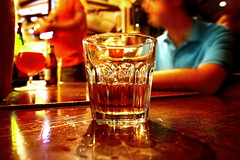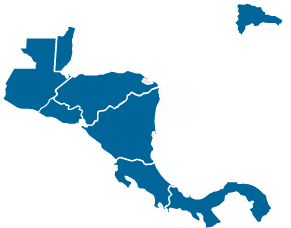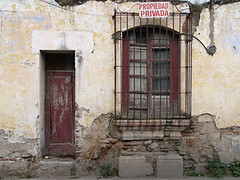Antigua Guatemala Doorway
This doorway is very narrow, I would hate to try and move furniture in or out of this door.
I believe that this is a picture of one of the old government buildings in Antigua.
The old world charm of these buildings is just like being in Europe.
Keep checking back for more pictures and personal stories of Guatemala.
Christina Aguilera visits villages in the Guatemalan highlands near Lake Atitlan
 Image via Wikipedia
Image via Wikipedia
Plaza Del Apolstol Santiago, Guatemala

Cerro de la Cruz

Botran Solera 1893

The Ron Botran brand of spirits was established in Quetzaltenango, Guatemala in 1939, situated at more than 7,500 feet above sea level. The corporation was founded in 1963 and they currently export a wide range of fine rums throughout the Americas, the Caribbean and Europe.
Botran Solera 1893 is distilled from virgin honey obtained from the sugar cane after undergoing a slow fermentation process. The rum is aged to perfection at an elevation of 2300 meters above seal level in small oak barrels. The rum is prepared using a blend of the finest rums of Casa Botran.
Botran Solera 1893 reveals a medium dark amber color due its aging in oak.
On the nose: Botran Solera offers a delicate caramel aroma, coupled with golden raisin, a hint of dried apricot tart-fruit, and a slight oaken vanilla foundation, leaving traces of almond
 Image by Morkai79 via Flickr
Image by Morkai79 via Flickr
Perfectly smooth to sniff with moderate complexity and no offensive alcohol aromas.
The initial taste is complex as you would expect of a rum matured in the rare Solera method, whereby rums of different vintages are periodically and sequentially blended, so that younger rums are blended with progressively older ones until a certain age and flavor is achieved.
A great rum for drinking alone or on the rocks.
Guatemala; Exploration For Oil And Natural Gas
 Image via Wikipedia
Image via Wikipedia
World Energy Research, a New Zealand-based energy research and investment company, is moving into energy exploration in Guatemala. WER plans to investigate the viability of 12 project sites with a focus on environmentally-friendly oil and natural gas extraction methods.
Of the 12 sites, three are natural gas reserves off the Pacific coast of Guatemala and nine are onshore sites located in the departments of Peten, Huehuetenango, Quiche and Alta Verapaz. All projects will be privately operated and based on contracts by the Guatemalan government.
This development is expected to bring multiple benefits to the area, including the creation of up to 1500 direct and indirect jobs in each project area. As well, World Energy Research is structuring plans for a long term and holistic preservation of the Maya Biosphere Reserve. Next to the Brazilian Rain Forest, the Maya Biosphere Reserve is the world's second largest oxygen producing natural habitat.
Chad Willis, managing director of World Energy Research, said, "This move into Guatemala will be an important advancement not just for our company and our investors, but also for Guatemala who will benefit from having their own sustainable energy market into the future, possibly even enough to develop their export markets." Guatemala is the largest oil-producing nation in Central America.
Nickel mine in Guatemala may resume operations
 Image via Wikipedia
Image via Wikipedia
Talks are underway to possibly reopen the Fenix nickel project in Guatemala. No start date has been set up yet. But economic conditions are looking favorable, the company's Guatemalan partner said on Thursday.
The company's Guatemalan partner said that the project, which HudBay bought in 2008 when it acquired Canadian miner Skye Resources was suspended as nickel prices plummeted in the wake of the global financial crisis.
A spokesperson for Compania Guatemalteca de Niquel or CGN HudBay's local partner, said a decision on restarting work at the mine in the eastern Guatemalan town of El Estor could be made later this year.
"We're still in 'slowdown' but there are some positive signs, nickel prices have improved and the global economic crisis has started to get better," Regina Rivera told Reuters.
The mine has a capital cost estimate of around $1 billion, which could change depending on how managers choose to power the plant.
Skye Resources which acquired the project in 2004, came up against local opposition to the reopening of the mine with squatters occupying company land and burning down a hospital and community relations office built by Skye.

Mysterious ruins may help explain Mayan collapse
 Image by Getty Images via Daylife
Image by Getty Images via Daylife
The Mayans from central America and Mexico were best known for best known for stepped pyramids, beautiful carvings and murals and the widespread abandonment of cities around 900 A.D.
Hidden in the hilly jungle, the ancient site of Kiuic (KIE-yuk) was one of dozens of ancient Maya centers abandoned in the Puuc region of Mexico's Yucatan about 10 centuries ago. It looks like they just packed up and walked away, says archaeologist George Bey of Millsaps College in Jackson Miss., co-director of the Labna-Kiuic Regional Archaeological Project. "Until now, we had little evidence from the actual moment of abandonment, it's a frozen moment in time."
New clues may come from Kiuic, where the archaeologists explored two pyramids and, most intriguingly, plantation palaces on the ridges ringing the center. Of particular interst: a hilltop complex nicknamed "Stairway to Heaven" by Gallareta (that's "Escalera al Cieloa" for Spanish-speaking Led Zeppelin fans) because of a long staircase leading from Kiuic to a central plaza nearly a mile away.
 Image by Michael R. Swigart via Flickr
Image by Michael R. Swigart via Flickr
Both the pyramids and the palaces look like latter-day additions to Kiuic, built in the 9th century, just as Maya centers farther south were being abandoned. "The influx of wealth (at Kiuic) may spring from immigration," Bey says, as Maya headed north. One pyramid was built atop what was originally a palace, allowing the rulers of Kiuic to simultaneously celebrate their forebears and move to fancier digs in the hills.

Guatemala Independance Day
On Sept. 15, 1821, the Central American colonies declared their independence from the Spanish crown.
Guatemala Independence Day History
From 1811 to 1818, Captain General José de Bustamante ruled the Kingdom of Guatemala. He suppressed all attempts toward independence thus preserving the region’s allegiance to Spain. King Ferdinand VII was restored to the Spanish throne after the French were defeated in Spain in 1814. However, a revolt ensued around 1820 in Spain thereby restoring the constitution of 1812. During this period local election campaigns followed in Central America and an intense political rivalry emerged between the liberal and the conservative factions of the elite.
Guatemala was fortunate to have gained independence from Spain without much blood being spilt compared to the wars that occurred to most countries of Latin America. On September 15, 1821, a council of distinquished personages in Guatemala City proclaimed independence from Spain and they formed a government with Gabino de Gainza, as the chief executive.
From 1898 to 1920, Guatemala was ruled by the dictator Manuel Estrada Cabrera, whose access to the presidency was helped by the United Fruit Company. It was during his long presidency that the United Fruit Company became a major force in Guatemala.
Secretary of State
On behalf of the people of the United States, I would like to extend my warm congratulations to the people of Guatemala as they celebrate the 188th anniversary of their Proclamation of Independence on September 15.
As school children parade through the streets and Guatemalans across the country and around the world join in the celebration of Independence Day, they can be proud of Guatemala’s accomplishments as a unique, multi-lingual, multi-ethnic nation. This is an opportunity to honor their rich cultural heritage and to reaffirm their commitment to democracy, equality, justice, and prosperity for all.
It will also be a day of celebration for Guatemalans in the United States, who are valued members of our own diverse nation and have contributed so much to our culture and our economy.
On this historic occasion, let me reaffirm the commitment of the United States to strengthen our partnership with Guatemala and work together to ensure a peaceful and prosperous future for all our people.
U.S. Drug Enforcement Administration.
The street value from heroin that would have been produced from the poppies was estimated at around $434.5 million dollars.
Drug traffickers from neighboring Mexico have turned San Marcos into a center of poppy cultivation, the Guatemalan police states.
Guatemalan security forces have destroyed more than $1.3 billion worth of opium poppies in San Marcos so far this year, according to officials.

Mexico, Venezuela, Brazil offer food for Guatemala
By Tom Johnson 9-17-09
Mexico, Brazil and Venezuela are responding to Guatemala's plea for help in coping with a food shortage.
President Alvaro Colom says Venezuela and Mexico offered to send rice and other basic grains. Colom says Brazil also offered help, but did not give details.
Guatemala estimates 400,000 families are "at risk of food insecurity" due to adverse weather, poor soil and economic troubles. The government says 25 children have died since January from malnutrition.
The World Food Program will distribute 20 tons of nutritional cookies in the worst-hit areas.
Colom announced the new offers of help on Wednesday, a week after he declared "a state of public calamity" to help mobilize resources.
Guatemala in International Tournament in Libya



![Reblog this post [with Zemanta]](http://img.zemanta.com/reblog_e.png?x-id=c8b28656-da2a-4022-a818-d969af25249d)
![Reblog this post [with Zemanta]](http://img.zemanta.com/reblog_e.png?x-id=fddbab95-6fc1-456f-bfd4-2068d89b1b9d)


![Reblog this post [with Zemanta]](http://img.zemanta.com/reblog_e.png?x-id=ebc4d9cb-67e6-4a5d-88c3-e0e04749f701)
![Reblog this post [with Zemanta]](http://img.zemanta.com/reblog_e.png?x-id=37cdaa57-9fb7-46d5-acb6-9c846488d779)
![Reblog this post [with Zemanta]](http://img.zemanta.com/reblog_e.png?x-id=928b6928-d329-4d87-a4eb-fec3a51d1c55)
![Reblog this post [with Zemanta]](http://img.zemanta.com/reblog_e.png?x-id=ef8c62a8-1e07-4c48-885d-bddb60d13317)
